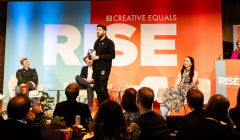
Are we leaving men and boys behind?
At Creative Equal’s RISE event, industry leaders consider how to reframe boys and men in marketing

In the age of hyper-personalisation, marketers are in danger of overlooking the power of mass market communications.

Do you ever get the feeling you are being watched? Being stalked across the web by products and services that you no longer need? Or, in the midst of coronovirus, products you can’t even access anymore?
The plethora of multi-platform touchpoints available to marketers has increased exponentially. But questions remain as to whether many brand’s ability to emotionally connect with consumers has increased at the same pace.
Of course, marketing has always included an element of personalisation. But the myth of one-to-one marketing at scale has perhaps been at the expense of long-term brand building. While the two are not mutually exclusive pursuits, all too often industry leaders have treated them as if they were.
With a new wave of direct to consumer brands, from sectors as diverse as food, fashion and finance continuing to unseat established brands, busting the myth of personalisation vs. mass market creativity is business critical.
With this in mind, we are asked a range of industry experts to share their view:
Surely the secret to great creativity in broadcast advertising is the same: keep it human.
Mark Runacus

Data driven personalisation has been a hot topic for a while now, and we’ve seen it executed with varying levels of success. While some have struck the right balance, there are those that have thrown frequency caps and consumer behaviours out of the window, which brings up the question of have they either misunderstood or over-estimated its’ impact? I’m sure many consumers and marketers can think of examples where it has felt a little too close to home or stalkerish with a product ad following them across the internet at some point.
Does this mean that data driven personalisation should stop? Absolutely not, but it also doesn’t mean that mass-market creativity is going to make a massive comeback; marketers need to focus on balance. Getting the right balance will demonstrate that brands understand their own business needs and priorities but also consumer demands and needs. It’s about knowing when the right moment is to reach new audiences and gain share of voice through mass market creativity. But then also how to design tailored experiences that support the consumer through their decision-making process.

I was delighted to speak at a recent event about personalisation where it was being discussed as a hot new topic. And that puzzled me a little. You see I grew up in what we used to call direct marketing where personalisation has been a thing for, well, as long as I can remember. I recall working on BT’s first personalised bills in the early 1990s - they look pretty much the same today - and on IBM’s first personalised website at the end of the last century. And as a Planner I was taught to always imagine that one single person that my creative brief is addressing.
The secret to effective personalisation hasn’t changed: keep it human.
I’m seeing too many examples of personalisation that are technological showboating. Just because the tech can do it, doesn’t mean you have to. Let’s have the customer in the room when we’re planning our personalisation strategies. You know what I mean; take a step back and ask yourself, is this really adding value to the customer’s experience and their relationship with our brand?
And surely the secret to great creativity in broadcast advertising is the same: keep it human.
Mass market creativity will make a comeback, but to be really successful you need cultural imprinting.
Mark Lloyd
Data powered personalisation is here to stay. The promise of one-to-one connections with customers delivered through mass-marketing, with a combination of data, interchangeable creative and automation turns broadcast into personal. Added to this the ability to monitor, report and adapt the messaging in real-time, and marketeers are offered nirvana: measurable ROI.
However, the ROI can be misleading. Often clients see significant uptick in Performance Marketing ROI without a corresponding impact to the bottom line i.e. new attribution of existing outcomes.
The role of brand is frequently under-valued in a performance world and yet it is the creative vision, design and communication of a brand strategy that gives the data targeted communication impact. It’s no coincidence that some of the biggest TV brand advertisers are new-era digital first brands; Amazon, Peloton, Deliveroo.
Creativity & brand are the foundations for data driven personalisation. The winners of the future are the ones who can combine both creativity and data for immediate and meaningful impact.

Yes, mass market creativity will make a comeback, but to be really successful you need cultural imprinting. And also, sport.
As advertisers, we’ve collectively tasted the sweet nectar of easily measurable metrics and now we’re hooked. We seek efficiency over effectiveness. Tailored messages over crafted execution and stalking people around the web instead of entertaining them. But most importantly, we’ve neglected one of the proprietary tenets of good advertising: cultural imprinting.
Cultural imprinting is what gives society a shared sense of humour and set of values. Great advertising brings this together with mass reach and creativity to change the cultural meaning of a product or brand, and in turn, how you are perceived by others when you use it. Not to change minds individually.
Our client Peloton understands this. It aims for mass reach, knowing that the majority of people who see their advertising won’t buy a bike. But for most of the customers that do, it’s important to them that everyone else knows what a Peloton is. It’s why BBC took over tube stations to advertise Killing Eve and why global online platforms such as TikTok and Spotify are investing in big poster sites.
Advertisers who reject the dogmatic ideology of hyper-personalisation and instead make themselves part of our shared culture will win in the long-term.
And a great way to do this is through sport. Lionesses. Superovers. Record-breaking marathons. Harry Kane not squaring the ball to Raheem Sterling. The biggest moments of cultural imprinting over the last five years have almost exclusively been in sport, which is why global powerhouse brands like McDonald’s, VISA and Nissan continue to invest heavily in it.
Data-powered personalisation has led us away from where advertising has been successful for decades, but with sport still showing the value brands can gain from cultural imprinting, there’s plenty of reasons they can still win without resorting to irritating online stalking.
Data powered personalisation is intensely rationale, but humans are emotional. We like brands that we feel get us, not just reach us, and this comes down to creative thinking.
Jamie Williams

Personalisation and being personal aren’t the same thing. 80% of marketers won’t invest in personalisation by 2025, but what exactly does that mean? The more I read around this, the more I realise that for many, the line between personalisation and relevance is blurred.
Marketing personalisation covers elements like retargeting using third party data, enabling customisation of a product or campaign, or addressing customers by first name in an email.
But, is personalisation relevant to customers? Nine times out of 10, it’s not. This is where being personal steps in.
Being personal is about using prompts and cues that you know about customers to deliver relevant and timely messaging that captures their attention and drives them to an action. The next level of sophistication is to take that data and learn from it, use it to identify a discrete need. Something customers don’t know they need, but absolutely do. Being personal allowed you to deliver the right message, at the right time, in the right channel.

I’m not sure it’s true to say that marketers have necessarily over-estimated the impact of data and personalisation, but I think it is true to say that it isn’t the answer to all marketing problems, and it hasn’t always been used in the best way. And yes, I think the focus is absolutely coming back towards creativity.
In almost every walk of life, the ability to evolve and to utilise the best technology and innovation is key to growth. And within marketing, data has changed the way we gain insights, target and re-target consumers, and shape campaigns. Giving specific messages to a specific audience at a specific time can be brilliantly effective for certain companies.
But in most cases, the ultimate long-term success of an overarching marketing campaign comes down to having a brilliant and big creative idea that enables brands to properly engage with consumers, and not just reach them. Data can certainly help maximise the impact of creativity, but it doesn’t often come up with big creative leaps and ground-breaking thinking. Data powered personalisation is intensely rationale, but humans are emotional. We like brands that we feel get us, not just reach us, and this comes down to creative thinking.
Data-powered targeting certainly has a big role to play in aiding conversion, but first you’ve got to make a brand distinctive and memorable with as many people as possible.
Nick Exford

That this question is still being asked in 2020 is kind of maddening, when the evidence in favour of mass-market creativity is so plentiful, clear, and compelling.
Sharp, Binet & Field have been banging on long enough for us to know by now how brands are built. Data-powered targeting certainly has a big role to play in aiding conversion, but first you’ve got to make a brand distinctive and memorable with as many people as possible.
There’s a reason campaigns which aim for fame are most effective of all: everyone sees the same ad, knows that everyone else has seen it, and wants to talk about it. This shared understanding of what a brand means underpins Kevin Simler’s theory of ‘cultural imprinting’: if everyone is to buy into the same idea of a brand’s place in culture, it simply can’t be achieved on a personalised one-to-one basis.
And while marketers have been lured by the promised efficiencies of targeted digital, it’s the costly signalling of media like TV, ‘the waste’, which is the bit that works, because it demonstrates utmost confidence in your brand. Digital is cheap but looks it.
On the flipside, the real waste in ad tech over the last decade has been eye-watering, with billions of dollars lost to fraud, and 80% of marketers planning to stop investment in personalisation due to lack of ROI and data management woes.
But brands are waking up just as TV’s unrivalled reach is eroding, as Ebiquity’s latest research shows, with attention and culture increasingly scattered and shattered over a myriad of channels and platforms. That makes reaching huge audiences a lot harder.
So, the question I ask myself every day really isn’t whether mass-market creativity will make a comeback. It’s how. And that will take all of our efforts as an industry to answer.

I imagine that data-driven creative sends a shiver down the spine of most creative designers. Personalisation can go too far. I’ve seen it happen. I suspect that your favourite advert doesn’t playback what time of the day it was or the day of the week.
There are some data-driven myths that I consistently see flagged in some digital creative conversations, especially when we’re talking about ‘dynamic’ executions. A great example of this is time of day data. We often hear a ‘we see spikes in traffic to our website during the early hours of the morning, and early evenings’, followed by, ‘how do we incorporate time of day into our messaging to recognise when our audiences are most engaged?’ For the most part it’s simply because more people are more active in these hours due to commutes. The time of day itself is not really a factor in why people are paying attention, so much as convenience.
When looking to data like this for insight you should first ask yourself three things. Firstly, is it relevant? Is it telling us more than we already know? Secondly, what is it telling me? How does your audience behave? And thirdly, is it a creative insight? And could it compel audiences to act?
If all are positive, it could have the potential to inform creative direction.
So, I agree that personalisation has been over-estimated, often because marketers are not being especially selective. That being said, I don’t know that a digital world ever needs a full mass-market approach either. The beauty of digital is that we can isolate small pieces of insight and use that to build something powerful that really works. I would add that we also obsess about over-personalising the creative. Actually, the creative is just the start of the journey. It’s the gateway to a much bigger story we can tell where data can really give us substantial insight as to what people want when they interact with our brands.
The idea of tailored, highly personalised messages for each individual target audience is so seductive for marketers that we have been chasing it for at least the last two decades.
Anthony Donaldson

YES. The idea of tailored, highly personalised messages for each individual target audience is so seductive for marketers that we have been chasing it for at least the last two decades. It makes us feel smart. It makes us feel that our industry is more science than art. It is one side of the coin that is magic and logic. Back when Customer Relationship Management was the new industry doctrine we were all encouraged to think that big databases would enable us to segment all of a brand’s customers and ensure that they received only the most relevant of marketing messages and that this would ensure their ever-lasting loyalty. In more recent years we have all benefited from the Eldorado of data from social media platforms, AI, chatbots and the like.
However more recently Byron Sharp has taught us that loyalty in most categories is a complete myth and that shoppers are a promiscuous lot who will happily skip from brand to brand as their fancy takes them. This has profoundly changed how most of us view marketing and the search for growth for our clients. Growth is why clients come to us. And the best way to grow is to talk to as many people as possible. Our creativity is only a means to reach as many people as possible. We need to talk to new and existing users all the time and as a result we need marketing that has the ability to engage with large groups of people.
I remember a marketer at Mars Confectionery telling me that the target audience for a forthcoming campaign was ‘anyone with a mouth’ and she wasn’t wrong. It was a big established brand with broad appeal in a very competitive market. Think of the marketing you remember. Think of the marketing your non-industry mates occasionally talk about. I’ll wager they are the big scale campaigns that made them feel something, that use emotion to really connect on a human level. This is the opposite of the atomised, data-driven, individualised, personalised marketing that often gets so much airtime in our industry.
This is not to say that data is worthless. Far from it. The more you know about what makes people tick, how and most importantly why they buy and use your products, the better and more insightfully emotional our creativity can be. Netflix’s is a case in point. It knows a lot about what I watch, when I watch and what I watch to the end (I would love to know the top movies that get started but less often viewed to the end). However, to grow Netflix focuses on its core offer: unlimited quality movies and TV programmes wherever you want to watch them. And it is the emotional benefit of watching this great content that will see its business grow. Not the super smart algorithm that means they know that I like Tarantino at the weekend and re-runs of Glee on a Monday. So, let’s make use of all the data we can get our hands on. Let’s draw meaning from those data points and feed it to our creative teams. But then let’s seek to reach as many people as we can through whatever touchpoints are most appropriate. It is much more ambitious, exciting and much more likely to lead to the growth we are paid to deliver.
Looks like you need to create a Creativebrief account to perform this action.
Create account Sign inLooks like you need to create a Creativebrief account to perform this action.
Create account Sign in